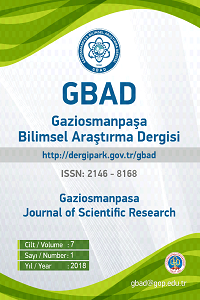Bilişsel Radyo Sistemleri için Kör Spektrum Algılama Yöntemlerinin 4 Farklı Haberleşme Kanallarındaki Performans Analizi
Günümüzde kablosuz haberleşme sistemlerinde hizmet standardının artmasıyla beraber, spektrum kıtlığı problemi ortaya çıkmıştır. Bu problemin üstesinden gelmek amacıyla mevcut frekans spektrumunun en verimli şekilde kullanılma ihtiyacı ortaya çıkmıştır. Bilişsel radyo teknolojileri belirtilen bu problemlere çözüm olmak amacıyla orta çıkan teknolojilerin bütünü olarak tanımlanır. Bilişsel radyo sistemlerinde ilk adım mevcut spektrumun dolu/boş durumunun algılanmasıdır. Bu algılama için kör yöntemler uygulama kolaylığı ve hesaplama maliyeti açısından tercih sebebidir. Bu çalışmada kör spektrum algılama yöntemlerinin rayleigh, nakagami-m, nakagami-n ve nakagami-q sönümlenmeli haberleşme kanallarındaki performans analizleri yapılmıştır. Çalışmada rasgele oluşturulan sıfır ortalamalı birincil kullanıcı ve gürültü işaretleri kullanılmıştır. Çoklu antenler tarafından alınan işaretlerin kovaryans matrislerinin özdeğerleri kullanılarak spektrum algılama yapılmıştır. Algılama olasılığı için uluslararası haberleşme komitesi tarafından izin verilen algılama olasılığı sınır değeri kullanılmıştır. Simülasyonlar MATLAB ortamında gerçekleştirilmiştir. Simülasyon sonuçlarına bakıldığında özdeğer tabanlı algılama için en iyi algılama performansının rayleigh sönümlü kanalında olduğu görülmüştür.
Anahtar Kelimeler:
Algılama teorisi, Bilişsel radyo, Rayleigh sönümlü kanal, Nakagami-m sönümlü kanal
Performance Evaluation of Blind Spectrum Detection Methods for 34 Different Communication Channels in Cognitive Radio Systems
In today's wireless communication systems, the problem of spectrum shortage has emerged with the increase of service standard. In order to overcome this problem, it is necessary to use the existing frequency spectrum most efficiently. Cognitive radio technologies are defined as the whole of the emerging technologies in order to solve these problems. The first step in cognitive radio systems is the detection of the full / empty state of the current spectrum. Blind methods for this perception are the reason for much preference in terms of ease of implementation and cost of calculation. In this study, performance analyzes of different communication channels of blind spectrum detection methods are performed. A randomly generated zero-mean primary user and noise signals are used in the study. Spectrum sensing was performed using the eigenvalues of the covariance matrices of the signals received by the multiple antennas. The generalized likelihood ratio detection is based on the detection probability limit value allowed by the international communication committee. Simulations were performed in MATLAB environment. As it is known, the channel that fully models the wireless 802.11 communication channel is the Weibull fading channel. Looking at the simulation results, it is seen that the best detection performance for the eigenvector detection is in the Rayleigh fading channel. However, weibull channel results should be taken into account when real applications do not fully accommodate rayleigh channel wireless channels. Moreover, according to the simulation results, the detection performance for the nakagami-m damped channel was found to be the most unsuccessful.
Keywords:
Cognitive radio Spectrum efficiency, Rayleigh Fading Channel, Weibull Fading Channel, 55 Nakagami-m Fading Channel,
___
- C. Çiflikli , F.Y .Ilgin; Covariance based spectrum sensing with studentized extreme eigenvalue , Technical gazette (accepted papers in press)
- D. Bhargavi , C. Murthy , Performance comparison of energy, matched-filter and cyclostationarity-based spectrum sensing, in: Proceedings of IEEE Eleventh International Workshop on Signal Processing Advances in Wireless Communications (SPAWC) ,Morocco, 2010, pp. 1–5.
- I. Sobron ,P. Diniz , W. Martins , Velez M.; Energy detection technique for adaptive spectrum sensing , IEEE Trans. Commun. 63 (3) (2015) 617–627
- J. Mitola, Jr. Maguire, G.Q. Cognitive Radio: making Software Radios More. IEEE Pers. Commun.,6, 4(1999), pp. 1318.
- M. Mishali, Y. Eldar , Blind Multiband Signal Reconstruction: Compressive Sensing for Analog Signals , IEEE Trans. Sig. Proc., 57, 3(2009), pp. 993–1009.
- M. Y. Zeng , Y.C. Liang , Q. Guo ,J. Xi , Y. Youming Li ,Y. Yu , Huang D. Spectrum Sensing Using Weighted Covariance Matrix in Rayleigh Fading Channels, IEEE Transactıons On Vehıcular Technology, 64, 11, (2015), pp. 5137-5148.
- N. Pillay , H.J. Xu, Blind Eigenvalue-Based Spectrum Sensing for Cognitive Radio Networks. IET Comm. 6,11 (2011), pp.1388-1396.
- N. Kapucu ,işbirlikçi haberleşme sistemlerinin farklı sönümlü kanallardaki başarım analizleri için yeni matematiksel ifadelerin türetilmesi,Kayseri,2012
- S. Chatterjee, A.Banerjee , Acharya T.; Maity S. P, Fuzzy c-means clustering in energy detection for cooperative spectrum sensing in cognitive radio system, in: Proceedings of Multiple Access Communications (MACOM) Sweden, 8715, (2014), pp. 84–97
- S.R Deo , On the Tracy-Widom Approximation of Studentized Extreme Eigenvalues of Wishart Matrices. Journal of Multivariate Analysis 147, (2016), pp.265.
- S. K.; Signal Processing for Cognitive Radios. John Wiley & Sons, Inc. Melbourne,2014.
- S. İngök; Bilişsel Radyoda Özdeğer Tabanlı Spektrum Sezme Yöntemleri ,İstanbul teknik Üniversitesi Fen bilimleri Enstitüsü,2013.
- T. Ratnarajah, R. Vaillancourt ; Alvo M.; Eigenvalues and condition numbers of complex random matrices, SIAM J. Matrix Anal.Appl., 26, 2(2005), pp. 441–456.
- Y. Mingchuan ,L. Yuan ,L. Xiaofeng ,T. Wenyan, Cyclostationary feature detection based spectrum sensing algorithm under complicated electromagnetic environment in cognitive radio networks , China Commun. 12 (9) (2015) 35–44.
- Y. Zeng , Y.C. Liang , Covariance based signal detections for cognitive radio, in: Proc IEEE International Symposium on and New Frontiers in DynamicSpectrum Access Networks (DySPAN 2007) , Dublin, Ireland, April 2007, 2007, pp. 202–207.
- ISSN: 2146-8168
- Yayın Aralığı: Yılda 3 Sayı
- Başlangıç: 2012
- Yayıncı: Tokat Gaziosmanpaşa Üniversitesi
Sayıdaki Diğer Makaleler
İdeal Hayvan Yetiştiriciliği İçin Veri Madenciliğine Dayalı Bir KDS Çalışması
Ukbe Usame UÇAR, Figen BALO, Gülsüm ERASLAN, Büşra ÇETİN
Grafen Takviyesi Miktarının Titanyum Matrisli Kompozitlerin Özelliklerine Etkisi
Fatih Yavuz ILGIN, Cebrail ÇİFLİKLİ, Tahir KARAKOÇ
Calculation of Performance Characteristic of In-Wheel Asynchronous Motor for Electric Vehicle
Uğur Demir, Mustafa Caner Aküner
PEM Yakıt Pili Kullanılarak DC-DC Buck Dönüştürücüsünün Modellenmesi ve Kontrolü
Menderes KAM, Ahnmet İPEKÇİ, Hamit SARUHAN
Üç Fazlı Senkron Bir Makinenin Değişken Yük Durumları için Geçici Hal Sonlu Eleman Analizi
Metin VARAN, İsmail ÖYLEK, Serkan DERELİ
Mahir Akgün, Hasan Basri Ulaş, Halil Demir
